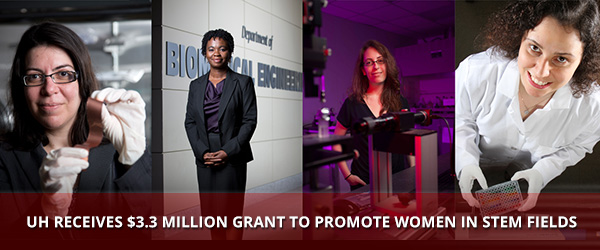| UH Receives $3.3 Million Grant to Promote Women in STEM Fields The University of Houston was awarded a $3.29 million grant over five years from the National Science Foundation (NSF) to increase the number and success of women faculty in the science, technology, engineering and mathematics (STEM) fields. The focus of the NSF “ADVANCE” program is to “increase the representation and advancement of women in academic science and engineering careers, thereby contributing to the development of a more diverse science and engineering workforce.” This award, which was spearheaded by the Cullen College, will allow the university to establish a “Center for ADVANCING Faculty Success” to oversee the goal of increasing female STEM faculty recruitment, especially among women of color, as well as enhancing UH’s infrastructure to make gender equity and diversity campus-wide priorities. Read more. News VIDEO: Introducing Christine Ehlig-Economides, Ph.D., NAE
The UH Cullen College of Engineering is proud to welcome Christine Ehlig-Economides to its faculty as the first-ever William C. Miller Endowed Chair Professor of petroleum engineering. A member of the prestigious National Academy of Engineering (NAE), Ehlig-Economides is the 9th NAE member to join the Cullen College’s faculty since 2008, bringing the total number of NAE members at the college up to 11. She became the first American woman to earn a Ph.D. in petroleum engineering when she obtained her doctorate from Stanford University in 1979. Read more and watch the video!.  | BME Professor Takes Outreach to Trinidad
Outreach is an important part of the UH Cullen College of Engineering’s mission, and many professors, staff members and students work in and around the Houston area promoting STEM education, involvement and research. Ravi Birla, associate professor of biomedical engineering, took it one step further. This summer, he took his outreach efforts on the road and travelled to Trinidad to speak to over 200 local students about engineering and the importance of STEM education. Read more.  | Researchers Draw Inspiration for Camouflage System From Marine Life
Researchers have developed a technology that allows a material to automatically read its environment and adapt to mimic its surroundings. The technology is described in a paper published this week in the Proceedings of the National Academy of Sciences. Cunjiang Yu, assistant professor of mechanical engineering at the Cullen College and lead author of the paper, said the optoelectronic camouflage system was inspired by the skins of cephalopods, a class of marine animals including octopuses, squid and cuttlefish, which can change coloration quickly, both for camouflage and as a form of warning. Read more.  | ECE Professor Developing Sodium-Ion Batteries with NSF Award
Last June, Texas Gov. Rick Perry drove an electric car made by Tesla Motors in front of the Texas State Capitol Building in Austin – a symbolic gesture meant to signify his intention of convincing Tesla executives to build their more than $4 billion battery factory right here in the Lone Star State. The timing of all of this couldn’t be better for battery research,” said Yan Yao, assistant professor of electrical and computer engineering at the UH Cullen College of Engineering. Yao recently won a three-year award from the National Science Foundation (NSF) totaling more than $340,000 to study sodium-ion batteries. Read more.  | Mechanical Engineering Professor Makes Headlines with MIT Postdoctoral Research
Hadi Ghasemi, assistant professor of mechanical engineering, is relatively new to the Cullen College of Engineering, but his postdoctoral work performed at the Massachusetts Institute of Technology (MIT) is making headlines even after his move to the Lone Star State. While at MIT, Ghasemi developed a new, cheap material that converts sunlight into steam. The material consists of a thin double-layered disc: the bottom layer is a spongy carbon foam that is both a flotation device and a thermal insulator, and the top layer is made up of graphite flakes that were exfoliated using a microwave. Read more.  | Mechanical Engineering Professor Wins IEEE Award for Superconducting Materials
Venkat “Selva” Selvamanickam, M.D. Anderson Chair Professor of mechanical engineering, has been named one of the first recipients of the inaugural 2014 IEEE (Institute for Electrical and Electronics Engineers) Dr. James Wong Award for Continuing and Significant Contributions to Applied Superconductor Materials Technology. According to the IEEE website, this award is intended to recognize individuals for “meritorious achievements and outstanding technical contributions” throughout their career in the field of applied superconductor materials technology. Read more.  | E&P Magazine Spotlights Subsea Engineering Program
The Cullen College of Engineering’s ever-expanding subsea engineering program made headlines this week in E&P Magazine’s “Training tomorrow’s subsea engineers.” The article highlights the program’s involvement with industry giants like FMC Technologies and KBR. The magazine spoke exclusively with Phaneendra Kondapi, KBR adjunct professor of subsea engineering, about the program. In the article, Kondapi mentions that a combination of baby boomers’ retirement and new subsea technology is what’s behind the sudden need for more highly educated and skilled subsea engineers. Read more.  | Chemical Engineering Professor Researches New Materials for 3-D Printing
The latest developments in three-dimensional printing technology are opening doors to advances in research fields like medicine, computing and electronics. But while these advances are promising, the feedstocks used in 3-d printing are still mostly limited to simple polymers, which are great for constructing trinkets and demo devices but not as useful when looking to create complex circuit boards or flexible, bendable wiring. Jacinta Conrad, assistant professor of chemical and biomolecular engineering, is doing her part to change that and more. Conrad just received a three-year, $299,479 grant from the National Science Foundation (NSF) to study the role of attractions in modifying the confined flow of colloids. Simply put, she and her research team are hoping to discover how to design better materials for applications like 3-d printing — and beyond. Read more. |









